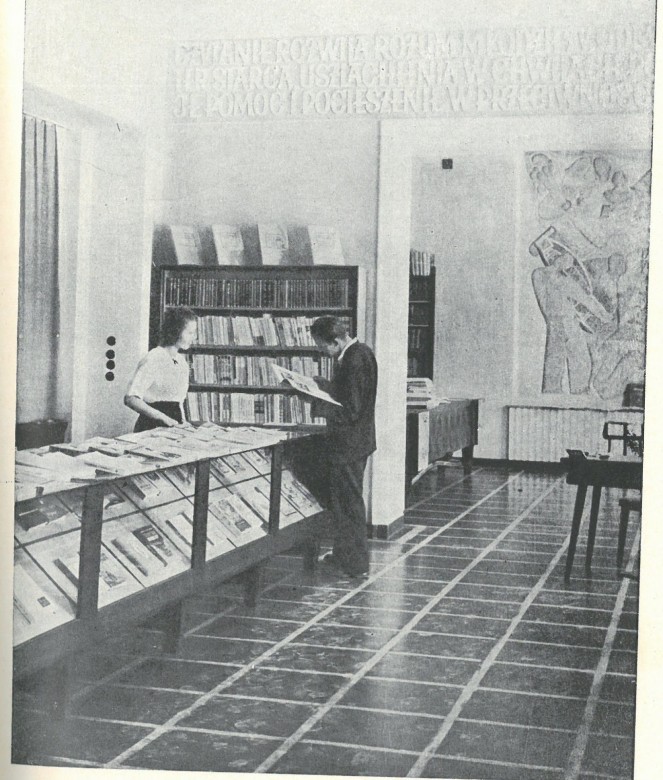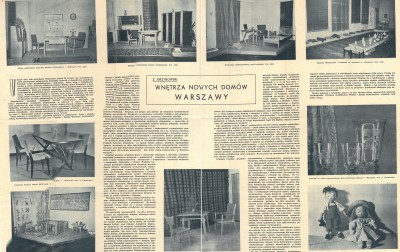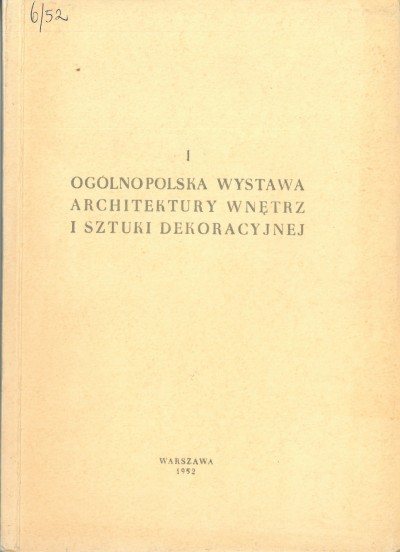1st National Exhibition of Interior Design and Decorative Art
26.05 – 23.07.1952 1st National Exhibition of Interior Design and Decorative Art
Zachęta Central Bureau of Art Exhibitions (CBWA)
exhibition organiser: Interior Design and Decorative Art Section of the Association of Polish artists and designers (in consultation with the Ministry of Culture and Art)
commissioner: Czesław Ługowski
artistic design of the exhibition: Eugeniusz Szparkowski (coordination), Jerzy Staniszkis (hall and stairwell), Czesław Wielhorski and Jarosław Gliński (art of exhibition arranging halls), Władysław Bojkow and Władysław Sowicki (interior design), Roman Mann (film stage design), Roman Wyłcan (decorations in front of Zachęta building)
number of works: 1,326
The organisation of this exhibition (Ogólnopolska Wystawa Architektury Wnętrz, hereafter OWAW) — as well as the subsequent three editions of the National Art Exhibitions (starting in 1950) and the Universal Exhibition of Architecture in 1953 (n.b. almost all of them took place at Zachęta) — was a manifestation of the centralism typical of the Stalinist organisation of artistic life in Poland. The rank of the event was confirmed by the officials attending the opening: Minister of Culture and Art Stefan Dybowski, Deputy Minister Włodzimierz Sokorski, Minister of Light Industry Eugeniusz Stawiński, representative of the Central Committee of the Polish United Workers’ Party Stefan Staszewski, director of the Central Board of Visual Arts Institutions Lucjan Motyka and Aleksander Rafałowski from the board of the Association of Polish Artists and Designers.
OWAW was defined in the catalogue as ‘the first major attempt to showcase, on a national scale, the post-war achievements in these areas of our art which are directly related to architecture, exhibitions, craft and factory production, as well as theatre and film art.’[1] However, unlike the above-mentioned art and architectural exhibitions, OWAW was not treated as a breakthrough and exceptional event — it was emphasised that it was an extension of earlier shows from 1946 and 1948, while the works from before Socialist Realism was decreed were widely represented (it should be noted that — apart from the presentation boards of individual trade fair and exhibition pavilions — exhibits were not dated as a rule).[2] Nevertheless, ‘the common characteristic of artistic work in all sections of the exhibition’ was clearly declared: ‘showing the ideological features of modernity, the features of the socialism we have raised in the material culture of our nation. Raising material culture to the rank of artistic creation is . . . a matter of great importance and political and ideological significance, a matter of great importance for the formation of a new lifestyle and a new type of human in People’s Poland’.[3]
Preparations for OWAW were not easy and we carried out in a rush. The organising committee was appointed at the end of 1951, the planned opening dates were postponed several times (March, then April, and then 9 May). The list of applications was finally closed on 16 April, when the Qualification Committee, chaired by Wojciech Jastrzębowski, began deliberations. As Aleksander Wojciechowski pointed out in his extensive critique of the exhibition, its shape was burned by the failure to invite the participation of the most important institutions and offices dealing with the issue of collaboration of artists with industry.[4] Another significant omission was the rejection by the Ministry of Culture and Art and the Management Board of the Association of Polish Artists and Designers of the proposal that part of the exhibition be made up of the example flats in newly built housing estates in Warsaw.[5]
The amount of material selected in a three-stage process was enormous. It represented the whole of the activity of the Interior Design and Decorative Art Section of the Association of Polish Artists and Designers — interior design, stage design, furniture, ceramics, exhibitions and textiles — which posed significant difficulty for the exhibitors. There were recurring accusations in the reviews: ‘the enormous number of exhibits of various purposes, the multitude of individual pieces of various types and artistic genre placed together somewhat resembled an antique shop’.[6] Two more general statements about the art of arranging exhibitions, published during the exhibition, resounded with these voices. Bohdan Urbanowicz postulate the ‘uniformity of the author’s concept’, i.e. the leading role of the artist in ‘conveying the received ideological thesis to the mass audience’.[7] Jerzy Sołtan, on the other hand, tried to emphasise a separate identity of the art of arranging exhibitions as a ‘homogeneous artistic discipline of a utilitarian character’ in an erudite text, which undoubtedly should be treated as building the prestige of the Department of Interior Design he was co-organising at the Academy of Fine Arts in Warsaw.[8]
The exhibition occupied all the rooms in Zachęta, including the main hall. The two largest rooms — Matejko and Narutowicz — housed spatial and architectural compositions. Paradoxically, the only reviewer who was in these displays was Zbigniew Herbert, who wrote in the Catholic Przegląd Powszechny under a pen name, intrigued by the Coal rotunda by Wojciech and Stanisław Zamecznik from the Recovered Territories Exhibition in Wrocław as an example of ‘the links between applied art and experimental directions of contemporary art’.[9] This was a nonconformist remark, even taking into account that other reviews from OWAW generally lacked — apart from minor interjections — ardent treatises on ‘constructivism’, known from other exhibitions and discussions at the time.
The focus of interest of the audience and reviewers was mainly furniture, followed by ceramics and textiles. Here, too, one could see a certain gap between the organisers and the expectations of the audience. Craft-produced interiors and furniture that were both representative and public utility rooms (or, as they were called at the time, social rooms) dominated the exhibition, while the expectations were of an offering in the area of commonly available furniture for private flats (n.b. the small number of model arrangements of residential interiors was explained by restrictions of the exhibition space). Prototypes of Mieczysław Puchała’s segmented furniture, foreshadowing the later wall-units, were the focus of attention. At the same time, the recurring question about the commercial availability of the exhibits showed that the interior design exhibitions gave to public — albeit to a small extent — an opportunity to express an opinion about the achievements of housing in People’s Poland, in a way heralding the wave of criticism that came after Stalin’s death. Perhaps this is why OWAW was not accompanied by a larger programme of events and accompanying meetings, which were, after all, part of the ritual of the social realist model of art.
The ceramics and fabrics commonly praised at the exhibition were, on the other hand, an opportunity for the authorities to show the propaganda-carrying collaboration of artists with workers in workshops and factories (e.g. the Grześkiewicz family’s factory in Włocławek), which, as a model of collective work, displaced the cooperative model that appeared at earlier exhibitions (none of them appeared at OWAW as individual exhibitors).
Marek Czapelski
Institute of Art History of the University of Warsaw
This compilation was prepared as part of the National Programme for the Development of Humanities of the Polish Minister of Science and Higher Education — research project The History of Exhibitions at Zachęta — Central Bureau of Art Exhibitions in 1949–1970 (no. 0086/NPRH3/H11/82/2016) conducted by the Institute of Art History of the University of Warsaw in collaboration with Zachęta — National Gallery of Art.
Bibliography:
Catalogue:
- I Ogólnopolska Wystawa Architektury Wnętrz i Sztuki Dekoracyjnej, May–June–July 1952. Warsaw: Centralne Biuro Wystaw Artystycznych, 1952
Source texts:
- A.W. ‘Tkaniny na wystawie architektury wnętrz i sztuki dekoracyjnej w Warszawie’. Biuletyn Instytutu Wzornictwa Przemysłowego [supplement to: Przemysł Włókienniczy, no. 10, 1952]
- ‘Chcesz się dowiedzieć, jak będą wyglądały meble, ceramika tkaniny i inne przedmioty codziennego użytku, idź na wystawę do Zachęty’. Express Wieczorny, no. 137, 1952
- Czajkowski, W. ‘Ceramika na wystawie architektury wnętrza i sztuki dekoracyjnej’. Przegląd Artystyczny, no. 3, 1952
- Czajkowski, W. ‘Ceramika w architekturze’. Przegląd Artystyczny, no. 6, 1952
- (esha). ‘„Zachęta” przygotowuje się do wystawy Architektury Wnętrz i Sztuki Dekoracyjnej’. Express Wieczorny, no. 37, 1952; Express Poznański, no. 39, 1952
- Grzybowski, Z. ‘Wnętrza nowych domów Warszawy’. Stolica, no. 13, 1952
- Gubrynowicz, Nina. ‘Artyści plastycy — ludziom pracy’. Głos Pracy, no. 137, 1952
- Gubrynowicz, Nina. ‘W poszukiwaniu nowych dróg’. Nowa Kultura, no. 26, 1952
- Guze, Joanna. ‘Wystawa architektury wnętrz i sztuki dekoracyjnej’. Świat, no. 25, 1952
- H. S. ‘Architektura wnętrza mieszkalnego’. Słowo Powszechne, no. 162, 1952
- Hertyński, Bolesław. ‘Ogólnopolska Wystawa Architektury Wnętrz i Sztuki Dekoracyjnej’. Przegląd Powszechny, no. 7–8, 1952
- Hest. ‘Estetyczne meble jak „łamigłówkę” każdy wedle gustu będzie mógł ustawiać w swoim mieszkaniu’. Express Wieczorny, no. 143, 1952
- Huml, Irena. Polska sztuka stosowana w XX wieku. Warsaw, 1978, pp. 170–173
- (mir-par). ‘Bliżej życia — obywatele architekci’. Życie Warszawy, no. 142, 1952
- ‘Nowe drogi i możliwości sztuki stosowanej’. Rzemieślnik, no. 26, 1952
- Nowicka-Mrozińska, Stanisława. ‘Więcej uwagi dla scenografii’. Teatr, no. 22, 1952
- ‘I Ogólnopolska Wystawa Architektury Wnętrz i Sztuki Dekoracyjnej’. Moda i Życie, no. 18, 1952
- ‘Otwarcie wystawy architektury wnętrz i sztuki dekoracyjnej’. Trybuna Ludu, no. 147, 1952
- Podhorska-Okołów, Stefania. ‘Sztuka na co dzień. Ogólnopolski pokaz architektury wnętrz’. Kurier Codzienny, no. 128, 1952
- ‘Przed I Ogólnopolską Wystawą Architektury Wnętrz i Sztuki Dekoracyjnej’. Trybuna Ludu, no. 335, 1951
- ‘Przed wystawą architektury wnętrz i sztuki dekoracyjnej’. Kurier Codzienny, no. 114, 1952
- (Rat). ‘Meble, gobeliny i wyroby ceramiczne wzbudzają podziw swym pięknem i praktycznością’. Słowo Powszechne, no. 128, 1952
- (tr). ‘Wystawa Architektury Wnętrz i Sztuki Dekoracyjnej’. Słowo Powszechne, no. 43, 1952
- Up., ‘Sztuka służy potrzebom mas’. Wola Ludu, no. 143, 1952
- ‘W marcu zobaczymy wystawę architektury wnętrz’. Słowo Powszechne, no. 3, 1952
- ‘Więcej piękna na co dzień’. Głos Olsztyński, no. 133, 1952
- Witwicki, Michał. ‘Uwagi na temat Wystawy Plastyki Użytkowej’. Architektura, no. 11, 1952
- Wojciechowski, Aleksander. ‘Problemy wystawy architektury wnętrza i sztuki dekoracyjnej’, Przegląd Artystyczny, no. 3, 1952
- (Wys.). ‘Wielka wystawa sztuki użytkowej otwarta będzie w „Zachęcie”’, Życie Warszawy no. 93, 1952
Press mentions:
- Dziennik Polski, no. 161, 6–7 July 1952
- Nowa Kultura, no. 2, 13 January 1952; no. 19, 11 May 1952; no. 23, 8 June 1952
- Przekrój, no. 374, 8 June 1952
- Życie Literackie, no. 2, 20 January 1952
Artists:
Maria Alkiewicz, Jerzy Bandura, Wacława Bartoszewicz-Strzelecka, Zbigniew Bednarowicz, Teodora Białokoz, Jolanta Bieguszewska, Jerzy Błaszczyk, Tadeusz Błażejowski, Bohdan Bocianowski, Aniela Bogusławska, Jan Bogusławski, Marian Bogusz, Władysław Bojkow, Adam Bowbelski, Barbara Brukalska, Stanisław Brukalski, Gwidon Budecki, Maria Bujakowa with a team of weavers from Zakopane (Katarzyna Ciułacz, Urszula Kołaczkowska, Władysława Kowalska, Antonina Kuligowska, Bolesława Lewandowska, Wanda Łypaczewska, Ewa Malinowska, Maria Maksowska, Zofia Marusarz, Helena Walczak, Karolina Warzecha), Helena Bukowska, Karolina Bułhak, Antoni Buszek with a team of female painters from the faience factory in Koło (Wacława Gibaszek, Anna Kowalska) as well as with a team from the faience factory in Włocławek (Adamczewska, Matwiejew, Troszczyńska, Zajkowska), Krystyna Butrym, Zofia Butrymowicz, Wanda Byrska, Stanisław Byrski, Mamert Celmiński, Józef Chierowski, Zygmunt Cichy, Edmund Czarnecki, Zofia Czasznicka, Apolinary Czepelewski, Konstanty Danko, Franciszek Dembski, Tadeusz Dembski, Irena Dewitz, Cecylia Dobrowolska, Daniela Droździecka, Juliusz Dumnicki, Danuta Duszniak, Zofia Dutkowska-Palowa, Gustawa Dyło-Ciupalska, Danuta Eimont, Roman Feniuk, Michał Filipowicz, Anna Fiszerowa, Tadeusz Forowicz, Jacek de Gaché, Henryk Gaczyński, Zofia Galińska, Andrzej Gałek, Helena Gałkowska, Stefan Gałkowski, Eugeniusz Geppert, Kazimiera Gidaszewska, Tadeusz Gierula, Jarosław Gliński, Hanna Główczewska, Józef Gniatkowski, Bogdan Gniewiewski, Stefania Gogolewska, Jan Gogolewski, Wanda Golakowska, Barbara Golczyk, Irena Golińska, Maria Gorełówna, Zygmunt Górski, Ewa Grajewska, Leon Grajewski, Maria Gralewska, Zofia Grmela, Tadeusz Gronowski, Helena Grześkiewicz and Lech Grześkiewicz with a group of painters from the faience factory in Włocławek (Maria Adamczewska, Józef Kędzierski, Jadwiga Kiełkowska, Jadwiga Szczepańska, Helena Troszczyńska, Zofia Wałęs, Salomea Zajkowska), Jan Hawryłkiewicz, Kazimierz Idczak, Zbigniew Ihnatowicz, Olga Imbierowicz, Danuta Jagielska, Stanisław Jarocki, Halina Jastrzębowska, Henryk Jaszczewski, Janina Jesipowicz, Aleksander Jędrzejewicz, Urszula Jungerman-Okupniak, Zbigniew Kaja, Tadeusz Kalinowski, Kazimierz Kamler, Alina Kardasz, Józef Kasarab, Tadeusz Kasprzycki, Lena Kawecka, Lesław Kiernicki, Adam Kilian, Halina Kintopf-Karpińska, Lucjan Kintopf, Karol Kłosowski, Czesław Knothe, Tadeusz Knot-Rolland, Aleksander Kobzdej, Zofia Kodis-Freyerowa, Maria Kokot, Urszula Kołaczkowska, Wanda Kosecka, Julia Kotarbińska, Jan Kowalczyk, Cecylia Kowalewska, Wacław Kowalik, Feliks Krassowski, Władysław Królikiewicz, Franciszek Kruszwicki, Jan Krzemiński, Rudolf Krzywiec, Władysław Księżyc, Halina Kucharska, Stanisław Kucharski, Teresa Kulejowska, Otton Kulikowski, Zdzisław Kulikowski, Stanisław Kurman, Jan Kurzątkowski, Wiesław Lange, Maria Leszczyńska, Eryk Lipiński, Wacława Lisowska, Franciszek Luterek, Aleksander Łącki, Czesław Łączka, Czesław Ługowski, Roman Madeyski, Łucja Majewska, Gustaw Majewski, Bogumiła Malec, Roman Mann, Wanda Manteuffel, Adam Marczyński, Barbara Massalska, Zofia Matuszczyk-Cygańska, Stanisława Miahczyłowicz-Wolska, Aleksandra Michalak, Borys Michałowski, Maria Miczyńska, Stefania Midowicz, Stanisław Miedza-Tomaszewski, Jadwiga Miklaszewska, Andrzej Milwicz, Stefania Milwiczowa, Stanisław Mizerski, Józef Mroszczak, Kazimierz Muszyński, Anna Narzymska, Anna Nikołajczuk, Bohdan Nowak, Roman Nyczka, Irena Obrembina, Maria Obrębska, Hanna Oknińska, Eugeniusz Olejniczak, Roman Orłow, Hanna Orthwein, Józef Oźmin, Irena Pać, Julian Pałka, Janina Passakas-Chudzikiewicz, M. Paszkiewicz, Lucyna Piasecka-Napiórkowska, Krystyna Piątkowska, Kazimierz Piętka, Stanisława Piętkowa, Irena Pikiel, Anna Piotrowska, Czesław Piwowarczyk, Pojata Plucińska, Zofia Plucińska, Eleonora Plutyńska with a team from the Experimental Centre in the Sokółka District (Aleksandra Bałakier, Felicja Jaroszewicz, Scholastyka Krupowicz, Aleksandra Redulska), Marta Podoska-Kochowa, Krystyna Policzkowska, Jan Poliński, Stanisław Preyzner, Jadwiga Pruszkowska-Zaremska, Jadwiga Przeradzka, Maria Przeździecka-Nieduszyńska, Zofia Przybyszewska, Ita Przyłuska, Stanisław Ptaszyński, Mieczysław Puchała, Henryk Rachalewski, Józef Rachwalski, Jan Radkowski, Ewa Radomska, Anatol Radzinowicz, Jadwiga Rauszer, Jerzy Romański, Teresa Roszkowska, Krystyna Różyska, Józef Różyski, Urszula Ruhnke, Joanna Rybińska, Halina Schiwujowa, Jacek Sempoliński, Zofia Siedlecka, Feliks Sienkiewicz, Marian Sigmund, Maria Sigmundowa, Alicja Siodłowska, Halina Skopińska, Zofia Sobecka, Ewa Soboltowa, Irena Sokołowska, Jerzy Sołtan, Tadeusz Sowicki, Władysław Sowicki, Jerzy Srokowski, Jola Stachowska-Cypryk, Zofia Stanisławska-Howurkowa, Jerzy Staniszkis, Henryk Starzyński, Anna Stawicka, Marian Stępień, Danuta Stępniewska-Libinowa, Andrzej Wiesław Stopka, Franciszek Strynkiewicz, Marian Strzelecki, Zenobiusz Strzelecki, Wiesława Studencka, Andrzej Stypiński, Stanisław Syciński, Tadeusz Szafran, Roman Szałas, Kazimiera Szałowska, Krystyna Szczepanowska with a team of weavers from Zakopane (Bolesława Lewandowska, Zofia Marusarz, Maria Siembab, Helena Toczek, Zofia Wilczek), Wanda Szczepanowska, Olgierd Szlekys, Eugeniusz Szparkowski, Zygmunt Szpingier, Joanna Szydłowska, Helena Szymańska, Danuta Szymankiewicz-Droździecka, Anna Śledziewska, Stefan Śledziński, Ewa Śliwińska, Bernarda Świderska, Jerzy Świdliński, Hieronim Śliz, Włodzimierz Tiunin, Henryk Tomaszewski, Jerzy Torończyk, Janina Trawińska-Łaszowska, Olgierd Vetesco, Władysław Vetesco, Władysław Wagner, Julia Wagnerowa, Eugeniusz Waniek, Janusz Warunkiewicz, Zenon Wasilewski, Czesław Wielhorski, Władysław Wincze, Alfred Wiśniewski, Jan Wiśniewski, Danuta Witkowska, Tadeusz Wojciechowski, Krystyna Wolińska, Maria Wolska-Berezowska, Władysław Wołkowski, Wacław Wołosewicz, Anna Wójcik, Roman Wyłcan, Maria Rudzińska-Wypych, Tadeusz Zaborowski, Jadwiga Zaczkowska, Wanda Zalewska-Zdun, Maria Zalińska, Stanisław Zamecznik, Wojciech Zamecznik, Jerzy Zaremski, Kazimiera Zarzycka, Józef Zboromirski, Irena Żmudzińska, Mieczysława Żmudzka, Wanda Żółtowska, Hanna Żuławska, Maciej Żwinis
[1] Janusz Bogucki, [introduction], in I Ogólnopolska Wystawa Architektury Wnętrz i Sztuki Dekoracyjnej, maj–czerwiec–lipiec 1952, exh. cat., Warsaw: Centralne Biuro Wystaw Artystycznych, [1952], p. 7.
[2] The two exhibitions took place at the National Museum in Warsaw: Folk Industry and Artistic Craft organised by the Department of Manufacturing of the Ministry of Culture and Art, and Exhibition of Artistic Industry, prepared by the successor of the Department — the Office of Production Aesthetics Supervision.
[3] Bogucki, pp. 12–13.
[4] These are the Institute of Industrial Design, the Centre for Folk and Artistic Industry, as well as the Department of Industrial Design at the Ministry of Light Industry. Aleksander Wojciechowski, ‘Problemy wystawy architektury wnętrza i sztuki dekoracyjnej’, Przegląd Artystyczny, no. 3, 1952, pp. 24–26.
[5] Ogólnopolska Wystawa Architektury Wnętrz 1957, exh. cat., ed. Józef Grabowski, Warsaw: Centralne Biuro Wystaw Artystycznych, 1958, p. 5.
[6] Michał Witwicki, ‘Uwagi na temat Wystawy Plastyki Użytkowej’, Architektura, no. 11, 1952, p. 293.
[7] Bohdan Urbanowicz, ‘Głos malarza o wystawiennictwie’, Przegląd Artystyczny, no. 3, 1952, pp. 31–32.
[8] Jerzy Sołtan, ‘U podstaw wystawiennictwa’, Przegląd Artystyczny, no. 3, 1952, p. 33–35.
[9] Bolesław Hertyński [Zbigniew Herbert], ‘Ogólnopolska Wystawa Architektury Wnętrz i Sztuki Dekoracyjnej’, Przegląd Powszechny, no. 7–8, 1952, pp. 105–106.
1st National Exhibition of Interior Design and Decorative Art
26.05 – 23.07.1952
Zachęta Central Bureau of Art Exhibitions (CBWA)
pl. Małachowskiego 3, 00-916 Warsaw
See on the map


